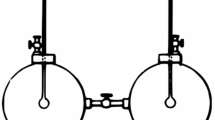Abstract
Our starting point consists of the microscopic dynamical equations of motion for the molecules, either classical or quantum mechanical. Subsequently the repeated randomness assumption is introduced, which breaks the time symmetry and produces the mesoscopic description in the form of a master equation for the probability distribution. Thereafter an expansion in the reciprocal system size leads to a macroscopic description, which may take one of two forms. Either it takes the form of a (nonlinear) deterministic rate equation for the macroscopic variables, tending to an equilibrium state; in this case the linearization around equilibrium produces the familiar Onsager reciprocal relations. Or it takes the form of a Fokker–Planck equation for the same variables; in that case a second expansion, this time in the temperature, leads to a nonlinear rate equation plus a dissipative term. The latter constitutes a nonlinear version of the Onsager equations.
Similar content being viewed by others
REFERENCES
L. Onsager, Phys. Rev. 37:405 and 38:2265 (1931). H. B. G. Casimir, Rev. Mod. Phys. 17:343 (1945). S. R. de Groot and P. Mazur, Non-Equilibrium Thermodynamics (North-Holland, Amsterdam, 1962).
R. Benguria and M. Kac, Phys. Rev. 46:1 (1981). H. Grabert, U. Weiss, and P. Talkner, Z. Phys. B 55:87 (1984). P. Mazur showed in Periodic Polytechnica, Ser. Chem. Eng. 41 (2) (1997) that Onsager came close.
N. G. van Kampen, Periodica Polytechnica, Ser. Chem. Eng. 41(2):157 (1997).
L. Boltzmann, Vorlesungen über Gastheorie (Barth, Leipzig, 1896 & 1898).
P. and T. Ehrenfest, Begriffliche Grundlagen der Statistischen Auffassung in der Mechanik, Encyklopädie der Mathematischen Wissenschaften IV, Vol. 32 (Teubner, Leipzig, 1912).
A. Nordsieck, W. E. Lamb, and G. E. Uhlenbeck, Physica 7:344 (1940).
H. A. Kramers, Physica 7:284 (1940). J. E. Moyal, J. Roy. Statist. Soc. B 11:150 (1949).
N. G. van Kampen, Can. J. Phys. 39:551 (1961).
L. van Hove, Physica 21:517 (1955); 23:441 (1957).
I. Müller, Z. Phys. 198:329 (1967). R. E. Nettleton, Phys. Fluids 2:256 (1959); 3:216 (1960).
N. G. van Kampen, Physica 20:603 (1954).
N. G. van Kampen, Stochastic Processes in Physics and Chemistry, 2nd Ed. (North-Holland, 1992), Section XVII, 7.
N. G. van Kampen, Phys. Lett. A 62:383 (1977).
Author information
Authors and Affiliations
Rights and permissions
About this article
Cite this article
van Kampen, N.G. The Road from Molecules to Onsager. Journal of Statistical Physics 109, 471–481 (2002). https://doi.org/10.1023/A:1020494010910
Issue Date:
DOI: https://doi.org/10.1023/A:1020494010910




